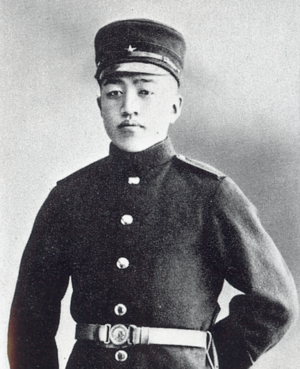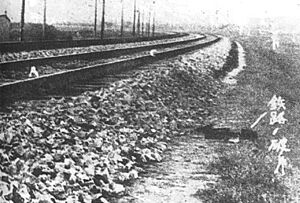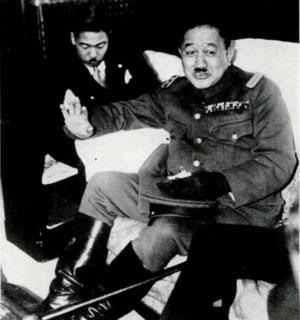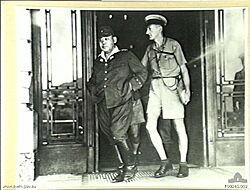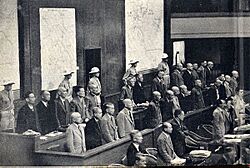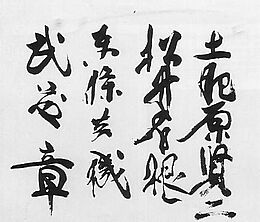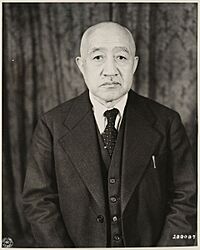Kenji Doihara facts for kids
Quick facts for kids
Doihara Kenji
|
|
|---|---|
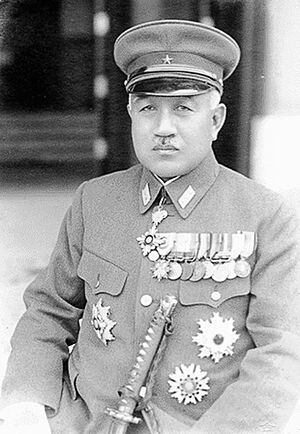
Doihara in c. 1941~45
|
|
| Nickname(s) | Lawrence of Manchuria, a reference to T. E. Lawrence |
| Born | 8 August 1883 Okayama, Japan |
| Died | 23 December 1948 (aged 65) Sugamo Prison, Tokyo, Occupied Japan |
| Cause of death | Execution by hanging |
| Allegiance | Empire of Japan |
| Service/ |
Imperial Japanese Army |
| Years of service | 1904–1945 |
| Rank | General |
| Commands held | 14th Division Fifth Army Seventh Area Army |
| Battles/wars | Siberian Intervention Second Sino-Japanese War World War II |
| Awards | Order of the Rising Sun |
Kenji Doihara (土肥原 賢二, Doihara Kenji, 8 August 1883 – 23 December 1948) was a Japanese army officer. As a general in the Imperial Japanese Army during World War II, he was instrumental in the Japanese invasion of Manchuria.
As a leading intelligence officer, he played a key role to the Japanese machinations that led to the occupation of large parts of China, the destabilization of the country, and the disintegration of the traditional structure of Chinese society to diminish reaction to the Japanese plans by using highly-unconventional methods. He became the sponsor behind many underworld activities in Japanese-occupied China.
After the end of World War II, he was prosecuted for war crimes in the International Military Tribunal for the Far East. He was found guilty and executed in December 1948.
Contents
Early life and career
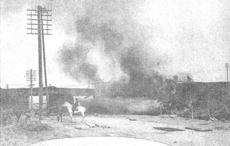
Kenji Doihara was born in Okayama City, Okayama Prefecture. He attended military preparatory schools as a youth, and graduated from the 16th class of the Imperial Japanese Army Academy in 1904. He was assigned to various infantry regiments as a junior officer, and returned to school to graduate from the 24th class of the Army Staff College in 1912.
Doihara spent most of his early career in various postings in northern China, except for a brief tour in 1921-1922 as part of the Japanese forces in eastern Russia during the Siberian Intervention. He was attached to the IJA 2nd Infantry Regiment from 1926 to 1927 and the IJA 3rd Infantry Regiment in 1927. In 1927, he was part of an official tour to China and then attached to the IJA 1st Division from 1927 to 1928.
He learned to speak fluent Mandarin Chinese and other Chinese dialects, and with this, he managed to take a position in military intelligence. From that post in 1928, it was he who masterminded the assassination of Zhang Zuolin, the Chinese warlord who controlled Manchuria, devising a scheme to detonate Zuolin's train as it traveled from Beijing to Shenyang. After that he was made a military adviser to the Kuomintang Government until 1929. In 1930, he was promoted to colonel and commanded the IJA 30th Infantry Regiment. In 1931, he became head of the military espionage operations of the Japanese Army of Manchuria in Tianjin. The following year, he was transferred to Shenyang as head of the Houten Special Agency, the military intelligence service of the Japanese Kwantung Army.
"Lawrence of Manchuria”
While at Tianjin, Doihara, together with Seishirō Itagaki engineered the infamous Mukden Incident by ordering Lieutenant Suemori Komoto to place and fire a bomb near the tracks at the time when a Japanese train passed through. In the event, the bomb was so unexpectedly weak and the damage of the tracks so negligible that the train passed undamaged, but the Imperial Japanese Government still blamed the Chinese military for an unprovoked attack, invaded and occupied Manchuria. During the invasion, Doihara facilitated the tactical cooperation between the Northeastern Army Generals Xi Qia in Jilin, Zhang Jinghui in Harbin and Zhang Haipeng at Taonan in the northwest of Liaoning province.
Next, Doihara took the task to return former Qing dynasty Emperor Puyi to Manchuria as to give legitimacy to the puppet regime. The plan was to pretend that Puyi had returned to resume his throne due to imaginary popular demand of the people of Manchuria and that although Japan had nothing to do with his return, it could do nothing to oppose the will of the people. To carry out the plan, it was necessary to land Puyi at Yingkou before that port froze; therefore, he had to arrive there before 16 November 1931. With the help of the legendary spy Kawashima Yoshiko, a woman well-acquainted with the Emperor, who regarded her as a member of the Chinese Imperial Family, he succeeded in bringing him into Manchuria within the deadline.
In early 1932, Doihara was sent to head the Harbin Special Agency of the Kwantung Army, where he began negotiations with General Ma Zhanshan after he had been driven from Qiqihar by the Japanese. Ma's position was ambiguous; he continued negotiations while he supported Harbin-based General Ding Chao. When Doihara realized his negotiations were not going anywhere, he requested that Manchurian warlord Xi Qia advance with his forces to take Harbin from General Ding Chao. However, General Ding Chao was able to defeat Xi Qia's forces, and Doihara realized he would need Japanese forces to succeed. Doihara engineered a riot in Harbin to justify their intervention. That resulted in the IJA 12th Division under General Jirō Tamon coming from Mukden by rail and then marching through the snow to reinforce the attack. Harbin fell on 5 February 1932. By the end of February, General Ding Chao retreated into northeastern Manchuria and offered to cease hostilities, ending Chinese formal resistance. Within a month, the puppet state of Manchukuo was established under Doihara's supervision who had named himself mayor of Mukden. He then arranged for the puppet government to ask Tokyo to supply "military advice". During the next months 150,000 soldiers, 18,000 gendarmes and 4,000 secret police came into the newly founded protectorate. He used them as an occupying army, imposing slave labour and spreading terror to force the 30 million Chinese inhabitants into abject submission.
Ma's fame as an uncompromising fighter against the Japanese invaders survived after his defeat and so Doihara made contact with him offering a huge sum of money and the command of the puppet state's army if he would defect to the new Manchurian government. Ma pretended that he agreed and flew to Mukden in January 1932, where he attended the meeting on which the state of Manchukuo was founded and was appointed War Minister of Manchukuo and Governor of Heilongjiang Province. Then, after using the Japanese funds to raise and re-equip a new volunteer force, on 1 April 1932, he led his troops to Qiqihar, re-establishing the Heilongjiang Provincial Government as part of the Republic of China and resumed the fight against the Japanese.
From 1932 to 1933, the newly promoted Major General Doihara commanded IJA 9th Infantry Brigade of IJA 5th Division. After the seizure of Rehe in Operation Nekka, Doihara was sent back to Manchukuo to head Houten Special Agency once again until 1934. He was then attached to IJA 12th Division until 1936.
For the key role he played in the Japanese invasion of Manchuria, he earned the nickname "Lawrence of Manchuria," a reference to Lawrence of Arabia. However, according to Jamie Bisher, the flattering sobriquet was rather misapplied, as that Colonel T.E. Lawrence had fought to liberate, not to oppress people.
Second Sino-Japanese War and Second World War
From 1936 to 1937, Doihara was the commander of the 1st Depot Division in Japan until the Marco Polo Bridge Incident, when he was given command of the IJA 14th Division under the Japanese First Army in North China. There, he served in the Beiping–Hankou Railway Operation and spearheaded the campaign of Northern and Eastern Henan, where his division opposed the Chinese counterattack in the Battle of Lanfeng.
After the Battle of Lanfeng, Doihara was attached to the Army General Staff as head of the Doihara Special Agency until 1939, when he was given command of the Japanese Fifth Army, in Manchukuo under the overall control of the Kwantung Army. In 1940, Doihara became a member of the Supreme War Council. From 1940 to 1941, he was appointed Commandant of the Imperial Japanese Army Academy. He then became head of the Army Aeronautical Department of the Ministry of War, and Inspector-General of Army Aviation until 1943. On 4 November 1941, as a general in the Japanese Army Air Force and a member of the Supreme War Council he voted his approval of the attack on Pearl Harbor.
In 1943, Doihara was made Commander in Chief of the Eastern District Army. In 1944, he was appointed the Governor of Johor State, Malaya, and commander in chief of the Japanese Seventh Area Army in Singapore until 1945.
Returning to Japan in 1945, Doihara was promoted to Inspector-General of Military Training (one of the most prestigious positions in the Army) and commander in chief of the Japanese Twelfth Area Army. At the time of the surrender of Japan in 1945, Doihara was commander in chief of the 1st General Army.
Prosecution and conviction
After the surrender of Japan, he was arrested by the Allied occupation authorities and tried before the International Military Tribunal of the Far East as a Class A war criminal together with other members of the Manchurian administration responsible for the Japanese policies there. He was found guilty on counts 1, 27, 29, 31, 32, 35, 36, and 54 and was sentenced to death. He was executed on 23 December 1948 at Sugamo Prison.
See also
- Japanese war crimes


